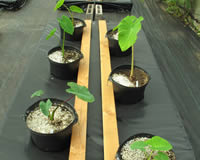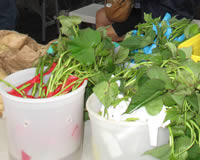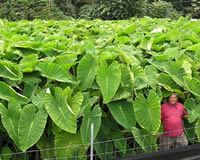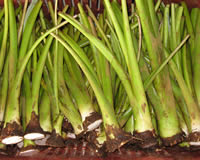Ginger

Edible ginger (Zingiber officinale) is a high-value crop in Hawaii. Bacterial wilt of ginger (caused by Ralstonia solanacearum race 4) has caused a precipitous decline in production since 1992-93. The bacteria persist for years in soil and much of the available land in Hawai`i Island is now unsuitable for ginger production after 15 years of outbreaks.
To down-load publication on ginger by CTAHR faculty:
- Experimental Non-Circulating Hydroponic Methods for Growing Edible Ginger
- Outdoor Growing of Clean Edible Ginger Seed by a Pot-in-Pot-in-Pot Sub-irrigation Method
Hydroponics

Hydroponic growing methods can provide high yields of vegetables while avoiding soil diseases, nematodes and weeds. Hydroponics generally refers to growing plants using nutrient solution (fertilizer + water)in situations where a growing medium is employed instead of soil as a substrate for roots. Water and fertilizer consumption is minimized in closed hydroponic systems. However, a commonly employed ‘run to waste’ growing technique involves an application of nutrient solution over a bag or slab of growing medium and the excess drains away. Many hydroponic systems require mechanical aeration or circulation of the nutrient solution and these include aeroponics, NFT and ebb and flow systems.
Non-circulating hydroponic methods
Hydroponic research at The Beaumont Agricultural Research Center has focused on non-circulating or passive hydroponic methods which are closed systems that utilize water and fertilizer very efficiently. These systems avoid the additional production costs and complexities associated with mechanical aeration and circulation including the need for electrical power and pumps which are required in many conventional hydroponic systems. The most common non-circulating hydroponic techniques involve suspended pot, floating topcover and sub-irrigation methods. The suspended pot method is a powerful technique for growing short-term vegetables such as lettuce because the entire crop can be grown with only an initial application of water and nutrients. The floating topcover method is very effective for watercress. Cucumbers, tomatoes and other long-term vegetables are typically grown with some version of a sub-irrigation method where additional nutrient solution is added throughout the life of the crop.
To down-load publications of CTAHR faculty:
- A Capillary, Noncirculating Hydroponic Method for Leaf and Semi-head Lettuce
- A Non-circulating Hydroponic Kit for Leaf and Semi-head Lettuce
- A Suspended Pot, Non-circulating Hydroponic Method
- Aluminum Does Not Accumulate in Lettuce Foliage When Grown by a Non-circulating Hydroponic Method in Recycled Aluminum Beverage Cans
- Experimental Non-Circulating Hydroponic Methods for Growing Edible Ginger
- Fertilizer Stock Solutions for Hydrosol for Lettuce
- Fertilizer Stock Solutions for Lettuce
- Fertilizer Stock Solutions for Watercress
- Growing Lettuce by a Float-Support Non-Circulating Hydroponic Method in Hawaii and Pennsylvania
- Growing Lettuce in a 5 Gallon Bucket
- Growing Watercress from Seed by a Non-circulating Hydroponic Method
- Hydroponic Lettuce Production Suggestions & Notes
- Non-circulating Hydroponic Cucumber Production in Plastic Trash Containers and Polyethylene-lined Barrels
- Non-circulating Hydroponic Methods for Growing Tomatoes
- Non-circulating Hydroponic Systems for Vegetable Production
- Observations on a Noncirculating Hydroponic System for Tomato Production
- Outdoor Growing of Clean Edible Ginger Seed by a Pot-in-Pot-in-Pot Sub-irrigation Method
- Plastic-covered Rainshelters for Vegetable Production in the Tropics
- Portable Grow Beds with Roll-out Plastic Tanks
- Production of High Tunnel Specialty Crops in Pennsylvania
- Shading and Periodic Replacement of Nutrient Solution Improve Production of Hydroponically-grown Watercress
- Sub-irrigation Methods for Growing Potatoes in Containers under a Rainshelter
- The Wheel Garden
- Three Non-circulating Hydroponic Methods for Growing Lettuce
Click here to hear a talk by Dr. Bernard Kratky on Low Technology Hydroponic Methods for Growing Potatoes in Hawaii:
Insects and Diseases
The UH Agricultural Diagnostic Service (ADSC) provides a fee-based service to identify insect pests and diseases. Click here for a current price list. Samples may be dropped off at a Cooperative Extension office on the Island of Hawa`i; click here to find the nearest locations. For hours of these offices, please contact us.
Or, visit The Plant Doctor, Dr. Scot Nelson
Lettuce

Leafy, semi-head, iceburg head and romaine lettuce types are grown in Hawaii. Lettuce is grown in soil and also by hydroponic methods. Lettuce is grown in fields and in rainshelters and greenhouses.
To down-load publications of CTAHR faculty:
- A Capillary, Noncirculating Hydroponic Method for Leaf and Semi-head Lettuce
- A Non-circulating Hydroponic Kit for Leaf and Semi-head Lettuce
- A Suspended Pot, Non-circulating Hydroponic Method
- Fertilizer Stock Solutions for Hydrosol for Lettuce
- Fertilizer Stock Solutions for Lettuce
- Growing Lettuce by a Float-Support Non-circulating Hydroponic Method in Hawaii and Pennsylvania
- Growing Lettuce in a 5 Gallon Bucket
- Hydroponic Lettuce Production Suggestions & Notes
- Lettuce Seedling Yield and Response to Preplant and Foliar Fertilization during Transplant Production
- Three Non-circulating Hydroponic Methods for Growing Lettuce
Links to non-CTAHR resources:
- Lettuce, endive, escarole production in Florida
- Guidelines for lettuce production in Arizona
- Leaf lettuce production in California
- Iceburg lettuce production in California
Onions, Bulb
Bulb onions are primarily grown in Kula, Maui, but the Lalamilo area of the Big Island has climate and soil similar to Kula. In 2007, $1.68 million dollars of bulb onions were grown in Hawaii, Oahu, and Kauai [USDA - National Agricultural Statistics Service].
Click here to purchase seeds from CTAHR.
To down-load publications of Hawai`i faculty:
- Click here to access a free publication on bulb onions
- Click here to find out about bulb onion trials on Maui
- Effect of Irrigation Rate on Nutrient Accumulation and Yield of ‘Yellow Granex’ Onions
- The Effects of Soil Water Movement on Onions Growing in a Plastic-covered Greenhouse
- Reducing Field Spoilage of Field Onions by Temporary Rainshelters
Pesticides Registered for Use
The Hawaii Pesticide Information Retrieval System (HPIRS) database contains information pertaining to pesticides currently licensed for distribution and sale in Hawaii. A common search is to see what pesticides might be registered for use on a particular crop. For example, you can check a “Site of Application” search to see what is registered for use on [crop of interest] in Hawaii.
A non-CTAHR website that is useful for obtaining pesticide labels and Material Safety Data Sheets (MSDS):
http://www.cdms.net/LabelsMsds/LMDefault.aspx?t=
You need to enter the specific brand name (correctly spelled) and click on search.
Sweet Potato

In 2007, sweet potato production was valued statewide at $2.7 million dollars [USDA - National Agricultural Statistics Service]. The majority of all production is on the Island of Hawai`i along the Hamakua Coast of Hawaii, and the principal variety that is grown for export is ‘Okinawan purple’.
Nutritious Food
The average sweet potato weighs 6.5 ounces (about 3/4 cup) and contains 180 calories. It supplies 14% of your daily carbohydrate requirement (good carbs) and 26 % of your daily fiber needs. Orange-fleshed varieties are rich in beta carotene and purple-fleshed varieties have more anti-oxidants than blueberries. In addition, all sweet potatoes have a low glycemic index. This index is a measure of how quickly foods are broken down into sugars in the human body and converted to body fat. High glycemic index foods (such as potato and many baked goods with high amounts of refined sugar) cause blood sugar levels to spike rapidly, followed by an equally rapid decrease (sugar high followed by a sugar low). In contrast, low glycemic index foods (such as sweet potato) release sugar into the blood more slowly, and are recommended for people with diabetes.
Crop Management
The major pest of sweet potatoes in Hawaii and around the world is the Sweet Potato Weevil. It feeds on roots, making the root-tubers inedible due to the ugly appearance, bitter flavor, and rotten smell that develop. To control the weevil, it’s important to rotate the planting of your sweet potatoes with other crops, and to remove old vines to prevent weevils from multiplying. Also, a commercial pheromone is available to attract adult males to disrupt their mating and to monitor the pest population in the field.
The most important disease of sweet potato is Black Rot. It is caused by a fungus that can result in complete loss of the crop after harvesting. The fungus can persist in the soil for 1 to 2 years in roots remaining in the field after harvest. As with the Sweet Potato Weevil, the best control method is to rotate your planting of sweet potatoes to once every 3 to 4 years and to remove all sweet potatoes from fields after harvest
Crop Knowledge Master contains general information on pest hosts, distribution, damage, biology, and management in the form of pest summaries. Go to: http://www.extento.hawaii.edu/kbase/Crop/cropmenu.htm and click on ‘Vegetables’ and then click on ‘Sweet Potato.’

Sweet Potato Harvester
Sweet potato harvesters can be useful in easing the strain on the backs of workers. In addition, it can help growers remove all sweet potato root-tubers from the field, an important task in disease management. Click here to view the operation of a Niplo sweet potato harvester imported from Japan.
To obtain planting materials of sweet potatoes:
You could obtain cuttings (shoots that are approximately 12 inches long) from neighbors or sweet potato farmers, but be careful to select planting materials that are free of pests and diseases. Or you could grow your own cuttings, by letting sweet potato tubers produce shoots.

To down-load publications or hand-outs of CTAHR faculty
- Farm and Forestry Production Guide to Sweet Potatoes
- Grow your own superfood!
- Sweet potato varieties
Taro

Taro is primarily grown in lo`i (wetland culture) on the Island of Kauai. On the Big Island, the value of sales is $173,000, including both wetland-grown taro (in Waipio Valley) and dryland-grown taro [USDA - National Agricultural Statistics Service].
To identify Hawaiian taro varieties:
Click here to view descriptions of taro varieties.
Crop Knowledge Master contains general information on pest hosts, distribution, damage, biology, and management in the form of pest summaries. Click on ‘Vegetables’ and then click on ‘Taro.’

To obtain propagating materials of taro to plant:
Typically taro is vegetatively propagated by ‘hulis’ or materials composed of approximately 12 inches of lower petioles with 0.25 inches of upper corm. To obtain ‘huli’, you could ask your neighbors or local taro farmers, but use care in selecting healthy ones. Alternatively, you could grow your own planting materials by letting taro corms produce sprouts from the ‘eyes’ or growing points, similar to the way that potatoes produce sprouts.
For facts about the recent controversies surrounding taro:
Down-load the facts about the now completed research on genetic engineering of taro
Tomatoes

In Hawai`i, tomatoes are grown in soil and by hydroponic methods. They are grown outside in field culture and in greenhouses and rainshelters.
To down-load publications of CTAHR faculty:
- Effects of Irrigation Rates on Meloidogyne spp. Larvae populations and Tomato Yields
- Greenhouse Tomato Production in Top and Sub-Irrigated Vertical Bag Culture
- Growth of Tomato on a Tropical Soil Under Plastic Cover as Influenced by Irrigation Practice and Soil Salinity
- Increasing Yields of Bell Pepper, Cucumber, and Tomato with Plastic Row Covers and Plastic Mulch
- Narrow Rainshelters for Trellised Tomatoes in the Tropics
- Non-circulating hydroponic methods for growing Tomatoes
- Observations on a Noncirculating Hydroponic System for Tomato Production
- Two-cluster Tomatoes Require Less Pesticide per 1000 kg of Salable Fruit than Eight-Cluster Tomatoes
- Yield Trials of Tomatoes in Greenhouses in Hawaii
- Increasing yields of greenhouse tomatoes in a Maile silty clay loam soil by alternating the row location
Other non-CTAHR links:
- Growing hydroponic tomatoes – University of Arizona, Controlled Environment Agriculture Center
- Production of greenhouse tomatoes – Florida Vegetable Production Handbook, Vol. 3.
- Nutrient solution formulation for hydroponic (perlite, rockwool, NFT) tomatoes in Florida
- Growing greenhouse tomatoes in soil and in soilless media. Harrow, Ontario
- Greenhouse tomato handbook. University of Mississippi
